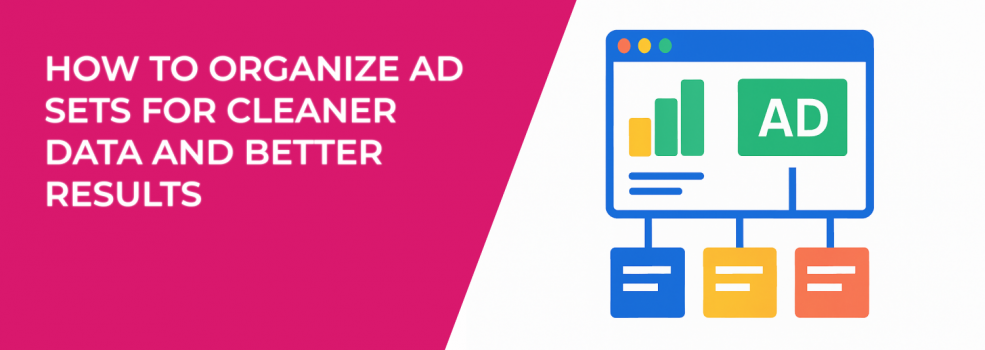If your ad sets aren’t organized, your data will always be confusing. You won’t know which audience is converting, which creative is working, or where your budget is being wasted. That makes scaling nearly impossible.
When you keep your ad sets structured and consistent, you get reliable insights and stronger results. Let’s walk through exactly how to do it.
Why Organized Ad Sets Matter
Messy ad sets make it hard to see what’s driving performance. You might get sales, but you won’t know why.
Organized ad sets help you:
-
Compare audiences accurately. You can see which group performs best.
-
Spot creative fatigue early. You’ll know when results start dropping.
-
Scale campaigns with less risk. Clean data gives you confidence to spend more.
In short, structure helps you make better decisions. If you’re struggling with delivery issues, you may also want to understand why Facebook sometimes shows “Ad Set May Get Zero” and how to fix it before reorganizing your campaigns.
Separate Your Audiences
One of the first rules of ad set organization is to keep audiences separate. If you put multiple audiences into the same ad set, you won’t know which one is responsible for conversions.
Here’s how you can break them down:
-
Lookalike audiences. People similar to your past buyers, email list, or loyal customers.
-
Interest-based audiences. Groups of people with specific hobbies, industries, or behaviors.
-
Retargeting audiences. Website visitors, people who engaged with your ads, or users who added products to their cart.
If you’re new to building audiences, check out this guide on how to define a target audience for marketing. It walks you through step-by-step methods to create segments that actually convert.
Assign Budgets That Work
Spreading your budget too thin is one of the most common mistakes. If you run five ad sets with only a small daily budget in each, you won’t collect enough data to know what’s working.
A better strategy is to run fewer ad sets at the start, but give them enough budget to gather meaningful results. If your average cost per purchase is $30, aim to give each ad set at least $60–$100 per day in testing.
This ensures you get enough conversions to decide whether the ad set should continue or be turned off. If you’re unsure whether to use ad set budgets or campaign-level budgets, see this breakdown of the difference between CBO and ABO.
Test One Variable at a Time
If you want clean data, don’t mix too many changes inside one ad set. Testing should be controlled and focused.
Here are three simple ways to structure your testing:
-
Keep the same creative, but test different audiences.
-
Keep the same audience, but test different creatives.
-
Keep both the creative and audience the same, but test placements separately.
This way, you’ll always know what caused a performance change. If you change too many things at once, your results won’t give you a clear answer. For a deeper dive, read about key strategies for Facebook ad testing.
Use Clear Naming Conventions
Clear names for your ad sets make reporting easier. When you look at results, you should know instantly what each ad set is testing.
A simple system could look like this:
-
LAL_2%_BOF_Video. Lookalike audience, 2%, bottom of funnel, video ad.
-
INT_Entrepreneurs_TOF_Image. Interest: entrepreneurs, top of funnel, image ad.
-
RET_SiteVisitors_MOF_Carousel. Retargeting site visitors, middle of funnel, carousel ad.
This type of structure helps you stay organized, especially when campaigns get bigger.
Review and Adjust Regularly
Ad set performance changes over time. That’s why you need to review results consistently.
When you check your account, ask:
-
Which ad sets are bringing conversions at the right cost?
-
Which ad sets are spending money but not performing?
-
Are multiple ad sets targeting the same people?
Turn off the ad sets that don’t perform and put more budget into the ones that do. This keeps your account efficient and focused.
Prevent Audience Overlap
If your audiences overlap, you may end up paying to show ads to the same people multiple times. This increases costs and makes your reporting less accurate.
To prevent this, use exclusions. For example:
-
Exclude past buyers from prospecting campaigns.
-
Exclude website visitors from cold-audience campaigns.
-
Exclude retargeting audiences when testing new interests.
You can learn more in this detailed guide on when to use exclude targeting on Facebook.
Match Ad Sets to Funnel Stages
Not all audiences are at the same stage in the buying process. Organizing ad sets by funnel stage keeps your messaging relevant and your data clean.
Here’s a simple breakdown:
-
Top of Funnel (TOF): cold audiences, lookalikes, and broad interests.
-
Middle of Funnel (MOF): site visitors, video watchers, and engaged users.
-
Bottom of Funnel (BOF): cart abandoners, email subscribers, and past buyers.
This structure ensures people see the right ad at the right stage, which improves performance and clarity.
Test Creatives in a Separate Ad Set
Creative testing should be intentional. If you mix creative tests with other variables, you won’t know what caused the difference in results.
A good approach is to run a separate ad set just for creative testing. For example, test three different videos against the same retargeting audience. Once you know which video performs best, use it in your main campaigns.
This method keeps your campaigns stable while still allowing for experimentation.
Final Thoughts
Ad set organization is one of the simplest ways to improve your advertising performance. By separating audiences, giving each ad set a meaningful budget, testing variables carefully, naming everything clearly, reviewing results regularly, and aligning with your funnel, you’ll create a system that produces cleaner data and stronger outcomes.
The more structured your ad sets are, the more confident you’ll feel in scaling your campaigns.

